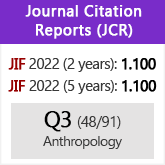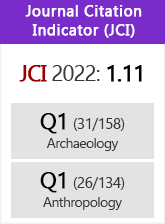Radiocarbon dates of the Iron Age hillfort of O Achadizo (Boiro, A Coruña, NW Iberia): an approach to the dating of marine shells
DOI:
https://doi.org/10.3989/tp.1999.v56.i1.296Keywords:
Iron Age hillfort, Radiocarbon, Isotopicfraccionation, Reservoir effectAbstract
The excavation of the hillfort of O Achadizo has brought to light several domestic structures intermingled with rubish heaps, belonging to the Iron Age Castro culture of NW Iberia. The abundant organic remains have constituted the basis for a systematic programme of radiocarbon dating of the different stratigraphic levels, which shows that the main occupation of the site took place between the VI and the II centuries cal. BC. Moreover, we have checked the 14C dates obtained from terrestrial samples (bones and charcoal) against those made on marine shells coming from the same strata. As a result, we have found that the latter have an apparent age of 316±I9 years, caused by the reservoir effect. Therefore, we stress the need for taking into account -and correcting whenever possible- such a deviation before using samples of marine origin for chronological purposes.
Downloads
Download data is not yet available.
Downloads
Published
1999-06-30
How to Cite
Rubinos Pérez, A., Fábregas Valcarce, R., Alonso Mathias, F., & Concheiro Coello, Ángel. (1999). Radiocarbon dates of the Iron Age hillfort of O Achadizo (Boiro, A Coruña, NW Iberia): an approach to the dating of marine shells. Trabajos De Prehistoria, 56(1), 147–155. https://doi.org/10.3989/tp.1999.v56.i1.296
Issue
Section
Reports
License
Copyright (c) 1999 Consejo Superior de Investigaciones Científicas (CSIC)

This work is licensed under a Creative Commons Attribution 4.0 International License.
© CSIC. Manuscripts published in both the printed and online versions of this Journal are the property of Consejo Superior de Investigaciones Científicas, and quoting this source is a requirement for any partial or full reproduction.All contents of this electronic edition, except where otherwise noted, are distributed under a “Creative Commons Attribution 4.0 International” (CC BY 4.0) License. You may read here the basic information and the legal text of the license. The indication of the CC BY 4.0 License must be expressly stated in this way when necessary.
Self-archiving in repositories, personal webpages or similar, of any version other than the published by the Editor, is not allowed.
















